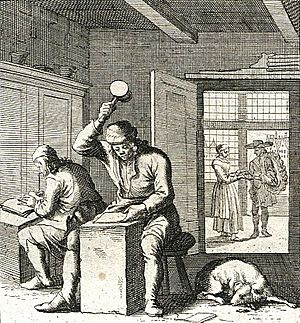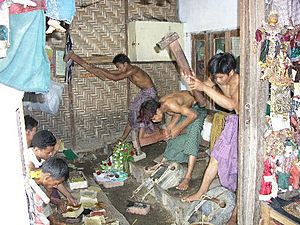Goldbeating facts for kids

Goldbeating is a special way of making gold super thin. Imagine hammering gold until it's like a tiny, shiny sheet! People use these thin sheets, called gold leaf, to decorate things. This process is called gilding. Gold leaf is so thin, it's almost see-through.
Contents
History of Goldbeating
Goldbeating is a very old skill. About 5,000 years ago, people in Ancient Egypt discovered how strong and bendy gold is. They became the first goldbeaters. They used round stones to pound gold into the thinnest sheets they could.
For thousands of years, the tools and methods for goldbeating haven't changed much. Even today, many of the techniques are similar to those used by the ancient Egyptians.
How Gold Leaf is Made
Making gold leaf is a careful process. It involves several steps, from melting the gold to hammering it into incredibly thin sheets.
Starting with Gold Bars
The color and purity of gold leaf can be different. This depends on how much silver or copper is mixed with the gold. Most goldbeaters make 23 karat gold leaf. This means it is very pure gold.
First, the gold and any other metals are put into a special pot called a crucible. This pot is heated in a furnace until the metals melt. The hot liquid gold is then poured into a mold. This makes it cool into a solid bar.
Next, this gold bar goes through a rolling mill many times. The rollers in the mill are moved closer together each time. This makes the gold bar thinner and thinner. It keeps getting rolled until it is about 25 micrometers thick. That's like 1/1000 of an inch!
Hammering the Gold Thin
After rolling, the long, thin gold ribbon is cut into one-inch squares. Now, the hammering begins!
The Cutch Stage
The first hammering step uses something called a cutch. A cutch is a stack of about 150 special sheets. Long ago, people used thin membranes from ox intestines. Today, other materials like Mylar are used.
A worker carefully picks up each small gold square with wooden pincers. They place one square in the middle of each skin. Once all the skins have gold squares, the cutch is wrapped tightly. It is held together with bands of parchment. Parchment is great because it can handle many hours of hammer blows.
The gold is hammered on a big, heavy block. This block is usually made of marble or granite. Sometimes, these stone blocks were placed on a tree trunk buried deep in the ground. This made the hammering more bouncy and effective.
Hammering the cutch by hand takes about one hour. A goldbeater uses a fifteen-pound hammer. They follow a special rhythm, hitting the packet up to seventy times a minute. The packet is turned and rotated. This makes sure the gold spreads out evenly in all directions. The small gold squares grow until they fill the four-inch square cutch.
The Shoder Stage
After the cutch stage, the gold is taken out. Each piece is cut into four smaller pieces with a knife. These new, smaller squares are put into a second packet. This one is called the shoder. A shoder has about 1,500 skins. The shoder is hammered for about three hours. The gold expands even more, becoming a five-inch square.
Finishing and Packaging
Once the gold is taken out of the shoder, it's placed on a surface covered in leather. The gold is so thin now that a worker can just blow on it to flatten it out.
Using a wooden tool called a wagon, the gold is quickly cut into four pieces. These pieces are immediately placed into a final packet called a mold. This is for the last round of hammering. The wagon has sharp cutting blades, often made from a type of cane.
The mold holds 1,500 pieces of gold. Before the gold goes in, the skins are coated with a fine powder called gypsum. This stops the super-thin gold leaf from sticking to the skins. The mold is hammered with an eight-pound hammer for three to four hours. The gold is beaten until it forms a circle about six inches wide.
The finished gold leaf is an unbroken sheet. It is incredibly thin, about 1/250,000 of an inch! After the leaves are taken from the mold, they are usually cut into a three and three-eighth inch square. Finally, they are packaged in tissue-paper books. Each book holds twenty-five leaves of beautiful gold.


